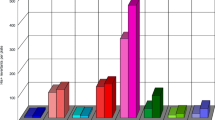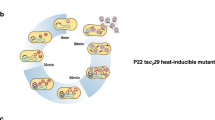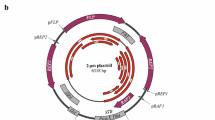Summary
When bacterial cells harboring a temperaturesensitive replication plasmid, which carries the particular ccd segment of a mini-F plasmid, are transferred to 42°C, cell division is inhibited after incubation for an appropriate time. The inhibition occurs, when the copy number of the plasmid decreases to become critically low, about one per cell (Ogura and Hiraga 1983 b). In λ phage lysogens carrying this type of plasmid, the prophage is induced in a small portion of the cell population under the same conditions, in addition to the inhibition of cell division in most of cells. The prophage induction, but not the inhibition of normal cell division, depends on normal recA function. Both induction of prophage and inhibition of cell division are suppressed by the simultaneous presence of a replication proficient plasmid carrying the ccdA gene. We discuss molecular mechanisms of the ccd function that couples host cell division to plasmid proliferation and induces the prophage. Additionally, we propose a hypothesis that the ccd mechanism of F plasmid contributes to indirect induction of prophage λ by an F plasmid damaged by UV-irradiation and then introduced into a lysogen via conjugation.
Similar content being viewed by others
Abbreviations
- kb:
-
kilobase pairs. m.o.i., multiplicity of infection
References
Bex F, Karoui H, Rokeach L, Dréze P, Garcia L, Couturier M (1983) Mini-F encoded proteins: identification of a new 10.5 kilodalton species. The EMBO J 2:1853–1861
Bolivar F, Rodriguez RL, Greene PJ, Betlach MC, Heyneker HL, Boyer HW, Crosa JH, Falkow S (1977) Construction and characterization of new cloning vehicles. II. A multipurpose cloning system. Gene 2:95–113
Borek E, Ryan A (1958) The transfer of irradiation-elicited induction in a lysogenic organism. Proc Natl Acad Sci USA 44:374–377
Borek E, Ryan A (1960) The transfer of a biologically active irradiation product from cell to cell. Biochim Biophys Acta 41:67–73
Capage MA, Scott JR (1983) SOS induction by P1 Km miniplasmids. J Bacteriol 155:473–480
Casaregola S, D'Ari R, Huisman O (1982) Role of DNA replication in the induction and turn-off of the SOS response in Escherichia coli. Mol Gen Genet 185:440–444
Cohen A, Fisher WD, Curtiss III R, Adler HI (1968) The properties of DNA transferred to minicells during conjugation. Cold Spring Harbor Symp Quant Biol 33:635–641
D'Ari R, Huisman O (1983) Novel mechanism of cell division inhibition associated with the SOS response in Escherichia coli. J Bacteriol 156:243–250
Devoret R, George J (1967) Induction indirecte du prophage λ par le rayonnement ultraviolet. Mutat Res 4:713–734
George J, Devoret R, Radman M (1974) Indirect ultraviolet-reactivation of phage λ. Proc Natl Acad Sci USA 71:144–147
Hashimoto-Gotoh T, Franklin FCH, Nordheim A, Timmis KN (1981) Specific-purpose plasmid cloning vectors. I. Low copy number, temperature-sensitive, mobilization-defective pSC101-derived containment vectors. Gene 16:227–235
Hiraga S, Saitoh T (1975) F deoxyribonucleic acid transferred to recipient cells in the presence of refampin. J Bacteriol 121:1000–1006
Inoue M (1971) Pleiotropic effect of the recA gene of Escherichia coli: Uncoupling of cell division from deoxyribonucleic acid replication. J Bacteriol 106:539–542
Karoui H, Bex F, Dréze P, Couturier M (1983) Ham22, a mini-F mutation which is lethal to host cell and promotes recA-dependent induction of lambdoid prophage. The EMBO J 2:1863–1868
Lane HED (1981) Replication and incompatibility of F and plasmids in the incFI group. Plasmid 5:100–126
Little JW, Mount DW (1982) The SOS regulatory system of Escherichia coli. Cell 29:11–22
MacQueen HA, Donachie WD (1977) Intracellular localization and effects on cell division of a plasmid blocked in deoxyribonucleic acid replication. J Bacteriol 132:392–397
Monk M (1969) Induction of phage λ by transferred irradiated coll DNA. Mol Gen Genet 106:14–24
Monk M, Gross J (1971) Induction of prophage λ in a mutant of E. coli K12 defective in initiation of DNA replication at high temperature. Mol Gen Genet 110:299–306
Moreau PL, Pelico JV, Devoret R (1982) Cleavage of λ repressor and synthesis of RecA protein induced by transferred UV-damaged F sex factor. Mol Gen Genet 186:170–179
Murotsu T, Matsubara K, Sugisaki H, Takanami M (1981) Nine unique repeating sequences in a region essential for replication and incompatibility of the mini-F plasmid. Gene 15:257–271
Ogura T, Hiraga S (1983a) Partition mechanism of F plasmid: Two plasmid gene-encoded products and a cis-acting region are involved in partition. Cell 32:351–360
Ogura T, Hiraga S (1983b) Mini-F plasmid genes that coupled host cell division to plasmid proliferation. Proc Natl Acad Sci USA 80:4784–4788
Ohki M, Tomizawa J (1968) Asymmetric transfer of DNA strands in bacterial conjugation. Cold Spring Harbor Symp Quant Biol 33:651–658
Oishi M, Smith CL (1978) Inactivation of phage repressor in a permeable cell system: Role of recBC DNase in induction. Proc Natl Acad Sci USA 75:3569–3573
Rosner JL, Kass LR, Yarmolinsky MB (1968) Parallel behavior of F and P1 in causing indirect induction of lysogenic bacteria. Cold Spring Harbor Symp Quant Biol 33:785–789
Rupp WD, Ihler G (1968) Strand selection during bacterial mating. Cold Spring Harbor Symp Quant Biol 33:647–650
Saitoh T, Hiraga S (1975) F deoxyribonucleic acid superinfected into phenocopies of donor strains. J Bacteriol 121:1007–1012
Schuster H, Beyersmann D, Mikolajczyk M, Schlicht M (1973) Prophage induction by high temperature in thermosensitive dna mutants lysogenic for bacteriophage lambda. J Virol 11:879–885
Timmis K, Cabello F, Cohen SN (1975) Cloning, isolation, and characterization of replication regions of complex plasmid genomes. Proc Natl Acad Sci USA 72:2242–2246
Yarmolinsky MB, Stevens E (1983) Replication-control function block the induction of an SOS response by a damaged P1 bacteriophage. Mol Gen Genet 192:140–148
Author information
Authors and Affiliations
Additional information
Communicated by W. Arber
Rights and permissions
About this article
Cite this article
Mori, H., Ogura, T. & Hiraga, S. Prophage λ induction caused by mini-F plasmid genes. Mol Gen Genet 196, 185–193 (1984). https://doi.org/10.1007/BF00328049
Received:
Issue Date:
DOI: https://doi.org/10.1007/BF00328049




